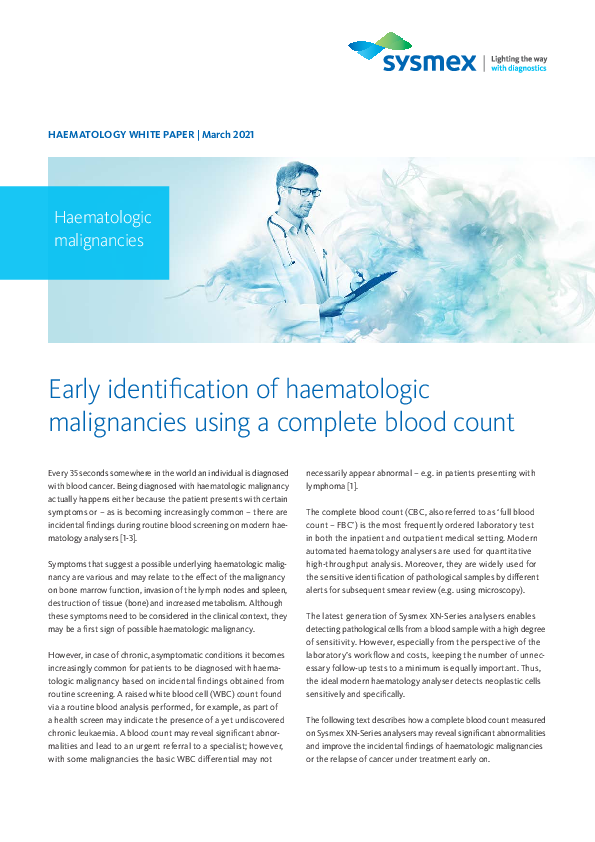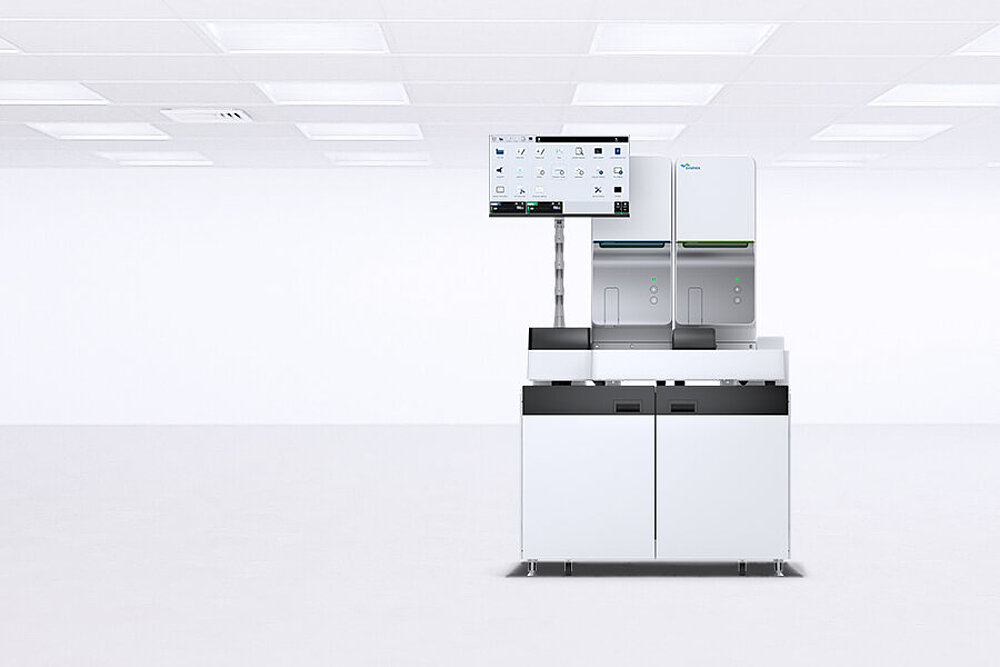Incidental findings of suspected malignant cells
Recognize the early signs of leukaemia already from standard blood cell count analysis
The complete blood cell count (CBC) is the most frequently ordered laboratory test in both the inpatient and outpatient medical setting. Modern automated haematology analysers are used for high-throughput analyses of complete blood counts. Moreover, these analysers are also widely used for the sensitive identification of pathologic samples, with conspicuous results indicated by different alerts for subsequent smear review, e.g. under a microscope.
Sysmex’s XR-Series and XN-Series analysers enable to detect pathologic cells in a blood sample with a high degree of sensitivity, so the blood count performed on such a state-of-the-art haematology analyser offers the opportunity of initial alert of many suspected malignant samples early, which would otherwise have remained unrecognized. The fact that every minute somewhere in the world an individual is diagnosed with blood cancer shows how important this is.
Benefits of analysing your blood samples on a Sysmex analyser
- Early findings of suspected malignant samples due to the sensitive detection of various pathologic cells [1-4].
- Very sensitive detection of nucleated red blood cells [1,2] indicating stress or damage to the bone marrow – performed with every blood count.
- Use of best-in-class proprietary algorithms on our modern haematology analysers flagging sensitively and specifically immature precursor cells [1-4] – with every differential blood count.
- A score for the timely detection of potentially unrecognized samples of chronic myelomonocytic leukaemia (CMML) [5].
- Unique parameters that support the identification of patients with a high likelihood of myeloproliferative diseases [6-8].
Download white paper

This white paper describes how a complete blood count measured on Sysmex XN-Series analysers may reveal significant abnormalities and improve the incidental findings of haematologic malignancies or the relapse of cancer under treatment early on.
Cases
Early indication of a chronic myelomonocytic leukaemia sample
A 62-year-old man visited his general practitioner for an annual preventive health check. At the time of visiting the physician, he did not suffer from any noticeable symptoms. The routine differential blood count performed on a Sysmex analyser showed all values within normal limits except for a mild monocytosis (MONO 1.3×10^3 cells/µL). Although this value was below the conventional cut-off for a monocytosis smear review, the sample was guided for microscopic examination in search of potential chronic myelomonocytic leukaemia (CMML) abnormalities.
The reason was that the laboratory had implemented the ‘Mono-dysplasia’ score and the result of this patient turned out to be positive. Careful examination of the blood smear showed marked dysplasia in neutrophils, which was also confirmed in several follow-up tests. Finally, this led to the suspicion of CMML sample , the diagnosis of which was confirmed by cytogenetic testing.
NRBC as early sign of malignancy
A 76-year-old man was admitted to a hospital’s emergency room for suspected heart failure. A blood count was performed on a Sysmex analyser and revealed the presence of mild monocytosis and circulating NRBC (0.02×10^3 cells/µL), which was confirmed by smear review. Due to the sudden appearance of acute ischaemia, the patient underwent an emergency aortocoronary bypass surgery. After one month, the man was discharged with a diagnosis of ischaemic heart disease. After 14 months, the patient returned to the hospital’s emergency room with a new acute exacerbation of chronic heart failure. A differential blood count analysis showed various pathologic cells including NRBC, immature granulocytes, blasts, and an abnormal morphology of RBC. Further tests lead to the diagnosis of primary myelofibrosis (PMF). The initial blood count by the Sysmex analyser had shown the presence of NRBC in peripheral blood more than one year before the diagnosis of PMF [9]. The excellent performance at low concentrations of NRBC shown by the Sysmex analysers is of valuable help in routine blood analysis, for instance when screening for many relevant malignancies in an early subclinical stage [1].
Our solutions
References
[1] Da Rin G et al. (2017): Performance evaluation of the automated nucleated red blood cell count of five commercial hematological analyzers. Int J Lab Hematol. Dec; 39(6): 663–70.
[2] Bruegel M et al. (2015): Comparison of five automated hematology analyzers in a university hospital setting: Abbott Cell-Dyn Sapphire, Beckman Coulter DxH 800, Siemens Advia 2120i, Sysmex XE-5000, and Sysmex XN-2000. Clin Chem Lab Med. Jun; 53(7): 1057–71.
[3] Blomme S et al. (2021): The integration of Sysmex XN-9100’ WPC channel reflex testing in the detection of reactive versus malignant blood samples. Int J Lab Hematol. Apr; 43(2): 191–198.
[4] Schuff-Werner P et al. (2016): Performance of the XN-2000 WPC channel-flagging to differentiate reactive and neoplastic leukocytosis. Clin Chem Lab Med. Sep 1; 54(9): 1503–10.
[5] Schillinger F et al. (2018): A new approach for diagnosing chronic myelomonocytic leukemia using structural parameters of Sysmex XN analyzers in routine laboratory practice Scand J Clin Lab Invest. May; 78(3): 159–64.
[6] Panova-Noeva M et al. (2011): JAK2V617F mutation and hydroxyurea treatment as determinants of immature platelet parameters in essential thrombocythemia and polycythemia vera patients. Blood. Sep 1; 118(9): 2599–601.
[7] Strati P et al. (2017): Novel hematological parameters for the evaluation of patients with myeloproliferative neoplasms: the immature platelet and reticulocyte fractions. Ann Hematol. May; 96(5): 733–8.
[8] Johnson S et al. (2019): ): A CBC algorithm combined with immature platelet fraction is able to identify JAK2 V617F mutation-positive polycythaemia vera patients. Int J Lab Hematol. Apr; 41(2): 271–6.
[9] Buoro S et al. (2016): Which clinical significance has automatic detection of very low levels of nucleated red blood cells in the peripheral blood? Ann Transl Med. Jun; 4(11): 230–4.






